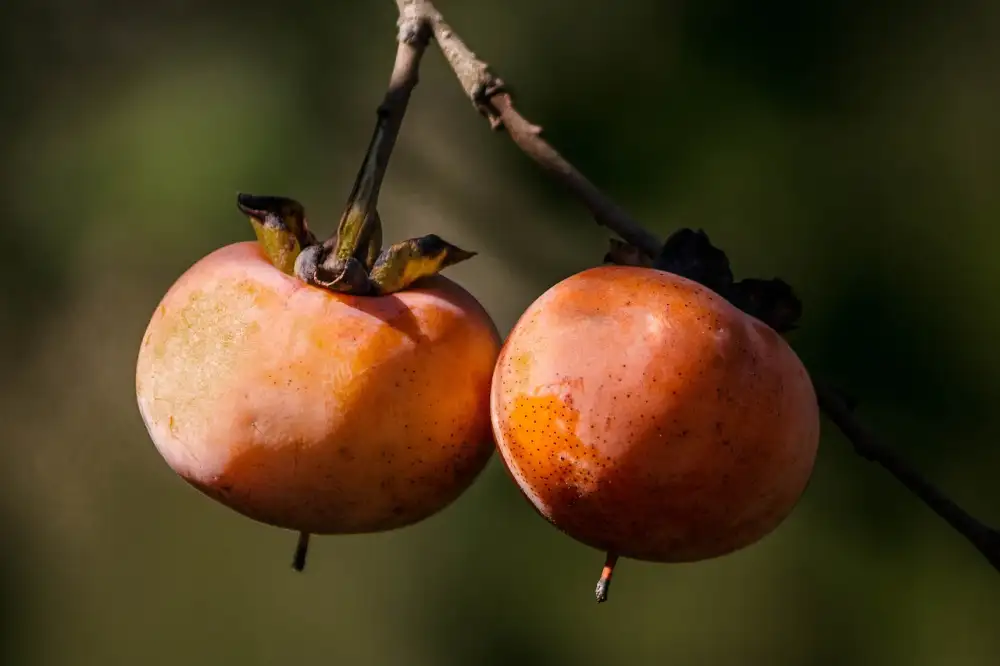Unveiling the Exquisite Delights of Persimmon: A Delectable Journey into the World of this Luscious Fruit

The persimmon fruit, with its vibrant orange color and sweet, honey-like flavor, is a true delight for the senses. Native to East Asia, this luscious fruit has been enjoyed for centuries and is now gaining popularity worldwide. Whether eaten fresh or used in various culinary creations, the persimmon offers a unique and unforgettable taste experience. Join us on a delectable journey into the world of this exquisite fruit as we uncover its origins, nutritional benefits, culinary uses, and more. Get ready to embrace the delightful persimmon in your culinary adventures!
Origins and History of Persimmon
The origins of the persimmon fruit can be traced back to ancient China, where it was highly regarded for its exquisite taste and medicinal properties. The fruit then spread to other parts of Asia, including Japan and Korea, where it became a staple in their cuisines.
Persimmons were later introduced to Europe by Spanish explorers in the 16th century. They quickly gained popularity among European aristocracy, who considered them a luxurious delicacy. The fruit eventually made its way to North America through trade routes, where it found a new home and became a beloved autumn treat.
Throughout history, persimmons have been celebrated for their vibrant orange color and sweet flavor. They have been used in various traditional dishes and desserts, showcasing their versatility in culinary creations.
Today, persimmons are cultivated in many countries around the world. Each region has its own unique varieties, each with its own distinct characteristics and flavors. From the Hachiya variety with its soft flesh perfect for baking, to the Fuyu variety that can be eaten crisp like an apple, there is a persimmon for every palate.
The rich history of persimmons is a testament to their enduring appeal and culinary significance. Whether enjoyed fresh or incorporated into mouthwatering recipes, this luscious fruit continues to captivate food lovers with its delightful taste and cultural heritage.
Varieties of Persimmon
The world of persimmons is as diverse as it is delicious. There are two main varieties of this luscious fruit: astringent and non-astringent.
The Hachiya persimmon is the most common astringent variety. It has a vibrant orange color and a unique, sweet flavor. However, it must be fully ripe before consuming, as unripe Hachiya persimmons can leave a bitter taste in your mouth.
On the other hand, the Fuyu persimmon is a popular non-astringent variety. It has a flattened shape and can be enjoyed even when slightly firm. Its flavor is mildly sweet with hints of honey and vanilla.
Other lesser-known varieties include the Maru, Gosho, and Rojo Brillante persimmons. Each variety has its own distinct taste and texture, adding to the delightful array of options for culinary exploration.
Whether you prefer the bold sweetness of the Hachiya or the subtle flavors of the Fuyu, there's no denying that persimmons offer an enticing range of choices for those seeking to indulge their taste buds in this exquisite fruit.
Nutritional Benefits of Persimmon
Persimmons are not only a delight to the taste buds but also offer a plethora of health benefits. Packed with essential nutrients, they are a great addition to any diet. One medium-sized persimmon contains approximately 81 calories and is fat-free, making it an ideal choice for those watching their weight.
These vibrant fruits are rich in vitamins A, C, and E, which are powerful antioxidants that help protect the body against harmful free radicals. They also contain high levels of dietary fiber, which aids in digestion and promotes a healthy gut.
Persimmons are an excellent source of potassium, an essential mineral that helps maintain proper heart function and regulates blood pressure levels. They also provide small amounts of calcium, iron, and magnesium, contributing to strong bones and overall vitality.
Moreover, persimmons are known for their high content of phytochemicals such as beta-carotene and lycopene. These compounds have been linked to reducing the risk of certain cancers and promoting eye health.
Including persimmons in your diet can boost your immune system due to their vitamin C content. This vitamin plays a crucial role in strengthening the immune system and fighting off infections.
With their low calorie count and numerous health benefits, persimmons make for a guilt-free indulgence that nourishes both the body and soul. So why not embrace this luscious fruit in your culinary adventures?
Culinary Uses of Persimmon
Persimmons are incredibly versatile in the kitchen, making them a favorite among chefs and home cooks alike. Their sweet and tangy flavor adds a unique twist to both savory and sweet dishes. Sliced persimmons can be added to salads, lending a refreshing burst of flavor. They can also be used in smoothies, jams, and chutneys for a touch of natural sweetness. Baked goods such as cakes, pies, and muffins benefit from the addition of persimmon puree, providing moisture and a hint of autumnal flavor. For an elegant dessert, try poaching persimmons in spiced syrup or roasting them with honey and cinnamon. With their vibrant color and delightful taste, persimmons are sure to elevate any culinary creation.
Popular Persimmon Recipes
1. Persimmon Salad: Toss ripe persimmons with mixed greens, goat cheese, and toasted walnuts. Drizzle with a tangy vinaigrette for a refreshing and healthy salad.
2. Persimmon Salsa: Combine diced persimmons with red onion, jalapeno, cilantro, lime juice, and a pinch of salt. Serve alongside grilled fish or as a topping for tacos.
3. Persimmon Smoothie: Blend ripe persimmons with Greek yogurt, banana, honey, and a splash of almond milk for a creamy and nutritious breakfast or snack.
4. Persimmon Jam: Cook peeled and chopped persimmons with sugar, lemon juice, and cinnamon until thickened. Spread on toast or use as a filling for pastries.
5. Persimmon Bread: Add pureed persimmons to your favorite banana bread recipe for a moist and flavorful twist on a classic treat.
These recipes showcase the versatility of persimmons in both sweet and savory dishes. Experiment with these ideas or create your own culinary masterpieces using this exquisite fruit!
How to Select and Store Persimmons
When selecting persimmons, it is important to choose fruits that are ripe but still firm. Look for persimmons with smooth, unblemished skin and a vibrant orange color. Avoid fruits that are too soft or have bruises.
To ensure the best flavor, store persimmons at room temperature until they are fully ripe. Once ripe, they can be stored in the refrigerator for up to a week. If you have unripe persimmons, you can speed up the ripening process by placing them in a paper bag with an apple or banana.
To extend the shelf life of persimmons, you can also freeze them. Simply peel and slice the fruit, then place the slices on a baking sheet lined with parchment paper. Freeze until solid, then transfer the frozen slices to a resealable bag or container.
Remember to wash persimmons thoroughly before consuming them. Enjoy this delightful fruit in its prime and savor its unique flavors in your culinary creations!
Tips for Preparing and Eating Persimmons
1. Choose ripe persimmons: Look for fruits that are deep orange in color and feel slightly soft to the touch. Avoid those that are still firm or have green patches.
2. Remove the stem: Gently twist off the stem of the persimmon before consuming or using it in recipes.
3. Peel or leave the skin on: Depending on personal preference, you can either peel the persimmon or eat it with the skin intact. The skin adds a slightly chewy texture and extra fiber.
4. Slice or dice: Cut the persimmon into slices, wedges, or cubes, depending on how you plan to use it in your dish. It can be added to salads, desserts, or enjoyed as a standalone snack.
5. Remove any seeds: Check for any seeds inside the persimmon and discard them before consuming. Most varieties of persimmons are seedless, but it's always good to double-check.
6. Enjoy fresh or cooked: Persimmons can be eaten raw, like an apple, for a juicy and sweet experience. They can also be baked, roasted, or used in various recipes such as jams, pies, and smoothies.
7. Pair with other flavors: Persimmons pair well with ingredients like cinnamon, ginger, honey, citrus fruits, nuts, and cheese. Experiment with different flavor combinations to enhance their taste.
8. Store properly: Keep unripe persimmons at room temperature until they ripen fully. Once ripe, store them in the refrigerator for up to a week to maintain their freshness.
By following these tips, you can fully enjoy the unique flavor and texture of persimmons in your culinary adventures!
Interesting Facts about Persimmon
1. Persimmons are native to China and have been cultivated for over 2,000 years.
2. The word "persimmon" comes from the Algonquian language, meaning "dry fruit".
3. There are two main types of persimmons: astringent and non-astringent.
4. Astringent persimmons need to be fully ripe before they can be eaten, while non-astringent persimmons can be enjoyed when slightly firm.
5. Persimmons are rich in vitamins A, C, and E, as well as dietary fiber.
6. The vibrant orange color of persimmons comes from their high levels of beta-carotene.
7. In Japan, persimmons are often used as decorations during the New Year celebrations.
8. Persimmon trees can live for over 60 years and produce hundreds of fruits each season.
9. The Hachiya variety of persimmon is often used in baking due to its sweet and creamy texture.
10. Persimmons have a unique flavor profile that combines sweetness with hints of honey and spice.
Discover these fascinating facts about persimmons and let their delightful taste enhance your culinary adventures!
In conclusion, the persimmon is a truly delightful fruit that deserves a place in your culinary adventures. Its unique flavor, versatility, and nutritional benefits make it a must-try ingredient. Whether you enjoy it raw, baked, or incorporated into various dishes, the persimmon will surely delight your senses. So next time you come across this luscious fruit, don't hesitate to embrace its exquisite delights and explore the endless possibilities it offers in your kitchen. Happy cooking!
Published: 20. 11. 2023
Category: Food



